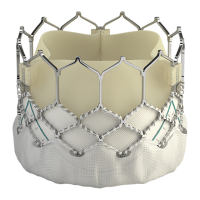23
Accountability of the S3OUS Cohort
Patients were treated at 14 investigational sites. Note that the intermediate risk patients enrolled in the
S3OUS study were excluded from the analysis presented herein. The database included 102 “all treated”
(AT) inoperable and high surgical risk patients. “All treated” population is defined to include all patients
who were enrolled in the trial and for whom the study valve implantation procedures were started (i.e., the
anesthesia was started).
One patient was excluded from the VI population. This patient experienced an aortic root rupture caused
by displacement of a large lump of calcium with sharp edges through the native aortic annulus following
balloon expansion of the SAPIEN 3 valve. The patient was subsequently converted to SAVR. After the
patient was weaned off cardio-pulmonary bypass, bleeding in the region of the dorsal root occurred, and
the patient died on the operating table.
A total of 56 patients were successfully implanted with a SAPIEN 3 valve via the transfemoral access
route, and 45 via the transapical/transaortic access route, as shown in Table 13.
Table 13:
Patient Accountability (S3OUS)
SAPIEN 3 Valve
Transfemoral Access
SAPIEN 3 Valve
Non-Transfemoral Access
(AT)
(VI)
(AT)
Valve Implant
(VI) Population
(AT)
Valve Implant
(VI) Population
All Treated (AT) Population consists of all patients who were enrolled in the trial and for whom the study
valve implantation procedures were started (i.e., anesthesia was started).
Valve Implant (VI) Population consists of all enrolled patients who received a SAPIEN 3 valve, and
retained the valve upon leaving the catheterization laboratory/hybrid suite.
Study Population Demographics and Baseline Parameters
The demographics of the S3OUS study population are shown in Table 14.
Patient Demographics and Baseline Characteristics
Demographics and Baseline
Characteristics
Valve
Overall
Transfemoral
Access
Non-Transfemoral
Access
New York Heart Association (NYHA)
class, no.(%):
Coronary artery disease, no.(%)
Previous myocardial infarction, no.(%)
Previous intervention, no.(%)

